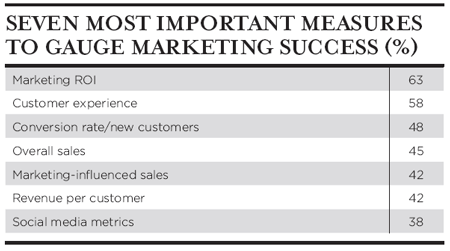Carolyn Heller Baird
The digital revolution is transforming the marketplace. This has left CMOs struggling to respond, as IBM’s Global CMO Study shows.
All of us are aware of the forces changing business and markets today. But how is the marketing profession responding? To understand this, IBM undertook its first-ever Global CMO Study. We engaged more than 1,700 chief marketing officers from 64 countries in hour-long, face-to-face interviews to uncover the dynamics of the CMO’s role as it evolves to respond to the digital era we now live in.
We found that market and technology factors are the two most powerful external forces affecting CMOs today. They expect these factors to drive increasing levels of complexity over the next five years, impacting not only what they market, but also fundamentally transforming how they do business.
The four biggest challenges they identified were the explosion of data; social media; the proliferation of channels and devices; and shifting consumer demographics. The struggle they all face is how to turn those challenges into opportunities. The good news is that CMOs also provided numerous practical ways marketing can manage the complexity of today’s environment, pointing toward a revised marketing profession for a new century.
Swamped by change
Consumers’ expectations are rising. They want better products and services, more choice and more value. And they expect organisations to act in a socially and environmentally responsible manner. Business customers are also buying more carefully, haggling harder over prices, demanding greater customisation, and looking for opportunities to pass risk back to their suppliers.
Meanwhile, globalisation has given customers everywhere many more options. Witness the fact that world export flows have soared from $7.9 trillion to $18.9 trillion in current US dollars over the past ten years. As with social media, anyone can become a publisher, broadcaster and critic. For example, the study noted reports in July 2011 that Facebook had more than 750 million active users, and the average user posts 90 pieces of content a month. Additionally, Twitter’s registered users send about 140 million tweets a day. And YouTube’s 490 million users upload more video content in a 60-day period than the three major US television networks created in 60 years.
In short, customers can see – and say – more about the organisations they deal with than at any time in history.
The digital ocean
At the same time, the digital revolution is providing unprecedented opportunities to engage with customers. But any business that wants to realise the potential of new information and communication technologies must first intercept and interpret vast quantities of data to find the meaningful parts.
The volume and variety of data are increasing with ferocious velocity. Navigating through this digital ocean to get a clear picture of customers is very difficult indeed.
CMOs, therefore, have to manage more data, understand and engage with more demanding customers, and ensure their employees consistently exemplify the organisation’s values. They have to use tools and technologies their children often understand better than they do. And they have an average tenure of just three to four years in which to make their mark.
Complexity multiplies
CMOs are well aware of the challenges that confront them. Nearly 80% of the CMOs interviewed believe the level of complexity will be high or very high over the next five years. But only 48% feel prepared to cope with it.
So, what are the main sources of concern? IBM probed more deeply to find out whether CMOs feel equipped to manage the impact of 13 key market factors. One of the most surprising findings from the study was that more than 50% of CMOs think they are under-prepared to manage 11 of these 13 factors.
 The data explosion tops the list of headaches. More than 70% of the CMOs who think it’s important say they aren’t fully prepared to deal with its impact. A number of CMOs commented that it isn’t data they lack, but rather the ability to derive meaningful insights from the plethora of data they already collect.
The data explosion tops the list of headaches. More than 70% of the CMOs who think it’s important say they aren’t fully prepared to deal with its impact. A number of CMOs commented that it isn’t data they lack, but rather the ability to derive meaningful insights from the plethora of data they already collect.
Social media, and the growing number of channels and devices from which customers can choose, are a close second and third in terms of the anxiety they generate. These concerns are clearly linked to the concern about the data explosion and the multitude of ways customers can now interact with a business.
The changing characteristics of consumers also feature prominently among CMOs’ biggest worries. 63% believe shifting consumer demographics will have a significant impact on their marketing functions. However, only 37% feel substantially or fully prepared to deal with the shift.
Delivering value
How can CMOs deliver value to empowered customers? Nearly all senior executives assert they want to understand their customers better. Indeed, in IBM’s 2010 CEO study, 88% of respondents said getting closer to customers was their top priority for realising their strategy over the next five years.
 However, as many of the CMOs we interviewed admitted, that’s much easier said than done. One reason mostorganisations struggle to get the customer insights they need is that they still focus on understanding markets rather than individuals. At least 80% of CMOs rely on traditional sources of information such as market research and competitive benchmarking to make strategic decisions. Similarly, more than 60% rely on sales, campaign analysis and the like.
However, as many of the CMOs we interviewed admitted, that’s much easier said than done. One reason mostorganisations struggle to get the customer insights they need is that they still focus on understanding markets rather than individuals. At least 80% of CMOs rely on traditional sources of information such as market research and competitive benchmarking to make strategic decisions. Similarly, more than 60% rely on sales, campaign analysis and the like.
Traditional sources of information are important, of course. However, most of them can only show customers in aggregate, offering little insight into what individual customers need or desire. The implications of these findings also impact market researchers who provide executives with the data they need to make informed strategic decisions. Research that spotlights market segments will only tell part of the story.
Relatively few CMOs are exploiting the full power of the digital grapevine. Although nearly three-quarters use customer analytics, only 48% are tracking consumer reviews, 42% third-party reviews, and just 26% are monitoring blogs. This is largely because the tools, processes and metrics they use are not designed to capture and evaluate the unstructured data produced by social platforms.
In short, new digital data sources can provide crucial insights into how customers and influencers think and behave. But to scale this effectively, organisations need to consider building fundamentally different relationships. They need to enable employees to engage with customers and provide customers and other constituents the ability to help one another. Today, only a small number of CMOs are currently capitalising on such opportunities, but as new marketing technologies make it easier to tap digital sources, we expect more CMOs will increasingly integrate new research approaches with their traditional sources.
Deal with big data
CMOs are also overwhelmingly under-prepared to take charge of the growing volume, velocity and variety of data. More than two thirds believe they will need to invest in new tools and technologies, and develop new strategies, for managing big data. When asked about their priorities for using technology in the next three to five years, 80% or more said they plan to increase their use of social media, customer analytics, customer relationship management (CRM), and mobile applications.
 However, CMOs who need to make decisions about technology investments may find themselves in unfamiliar territory. The majority of CMOs are not confident they can predict the potential return on their technology investments. They also cite relationship challenges with their organization’s IT function. These concerns suggest CMOs will have to work much more closely with CIOs in the future.
However, CMOs who need to make decisions about technology investments may find themselves in unfamiliar territory. The majority of CMOs are not confident they can predict the potential return on their technology investments. They also cite relationship challenges with their organization’s IT function. These concerns suggest CMOs will have to work much more closely with CIOs in the future.
In addition, nearly two thirds say they need to change the mix of skills within their marketing teams to include more people with strong analytics, digital and financial capabilities. However, we were surprised to find relatively few CMOs are thinking about the profound policy implications of big data, especially those relating to privacy and security. Only 28% consider it necessary to revisit their privacy policies, despite customers concerns over use of their personal information.
Enhancing customer loyalty
It’s not enough just to understand customers, of course. An organisation also has to act on what it learns – and do so faster than its competitors. Nowadays, it’s easy for disaffected customers to go elsewhere. This explains why CMOs say their top priority in this digital age is enhancing customer loyalty.
In the past, customers typically started the purchasing process by looking at a large number of brands and systematically narrowing down their choices. But the traditional marketing ‘funnel’ has now become a series of loops. Customers evaluate a shifting array of options.
They consult peers, family members, independent experts, and retailers or manufacturers, although the latter come last on the list. Once the transaction is complete, many enter into an open-ended relationship with the brand, sharing their experience widely online. The ‘funnel’ typically fails to capture this, because it ends at the moment of sale.
Approaches that focus solely on sales therefore miss the opportunity to build shared beliefs and lasting connections, or even inspire customers to be brand or company advocates. CMOs from the most successful organisations have already adjusted their marketing strategies to reflect this change.
Outperforming organisations use data much more extensively than under-performing organisations throughout the entire customer lifecycle. The differences are particularly marked in the phases devoted to stimulating awareness and desire, and building advocacy after the sale.
To deal with these challenges, CMOs must jumpstart relationships to capitalise on new digital channels to stimulate conversations with existing and potential customers, and create new types of relationships to reveal untapped opportunities. They also need to connect and engage with their customers and citizens at every stage in the customer lifecycle, and build online and offline communities to strengthen their brand.
Demonstrate accountability through ROI
CMOs are also being challenged to accurately measure the success of their marketing initiatives. Years ago, it was enough to point to advertising recall, brand perception or website traffic. Today, CMOs are under pressure to provide quantifiable evidence of how their marketing expenditure is helping the organisation achieve its goals.
CMOs need to know which initiatives deliver the best returns, and are aware that they will have to be much more financially accountable in the future. In fact, 63% of respondents believe marketing ROI will become the most important measure of success over the next three to five years.
From stretched to strengthened
The pressure to be accountable to the business is not just a symptom of tough economic times. It is a permanent shift that requires new approaches, tools and skills. The combined insights of the CMOs who participated in our study point to three strategic imperatives CMOs can act on to strengthen their likelihood of success:
- Deliver value to empowered customers – CMOs need to create value for customers as individuals, not just market segments. They need to tap new digital channels to better understand customers, and pay more attention to the impact their privacy policies have on customers’ trust in the brand.
- Foster lasting connections – CMOs need to leverage new digital channels to build customer relationships beyond the point of transaction.
- Capture value and measure results – CMOs need to use advanced analytics and compelling metrics to improve decision making, and to demonstrate accountability. They need to enhance their teams with people who have deep analytic, financial and digital skills.
Marketing executives can begin with practical steps:
- Create small action teams to develop recommendations for some key challenges highlighted in this study. Breaking the challenges into smaller chunks enables teams to address the big picture as well as the details and dependencies. It can also help identify opportunities for small wins and boost support for more radical initiatives.
- Schedule time to talk with C-suite peers. Consult the CIO about how to improve marketing tools and technologies, and talk to the CFO as a partner in developing the appropriate marketing metrics.
- View the organisation from a customer’s perspective. While CMOs may believe they already capture information about the customer experience, all the data in the world cannot replace what it feels like to walk in your customers’ shoes.
Carolyn Heller Baird is global director of the IBM 2011 CMO Study, “From Stretched to Strengthened: Insights from the Global Chief Marketing Officer Study,” IBM Institute for Business Value, October 2011. To download a copy of the full report or access industry or regional perspectives, go to ibm.com/cmostudy.



